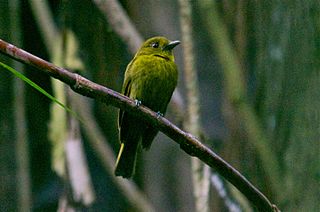Related Research Articles

The Pelecaniformes are an order of medium-sized and large waterbirds found worldwide. As traditionally—but erroneously—defined, they encompass all birds that have feet with all four toes webbed. Hence, they were formerly also known by such names as totipalmates or steganopodes. Most have a bare throat patch, and the nostrils have evolved into dysfunctional slits, forcing them to breathe through their mouths. They also have a pectinate nail on their longest toe. This is shaped like a comb and is used to brush out and separate their feathers. They feed on fish, squid, or similar marine life. Nesting is colonial, but individual birds are monogamous. The young are altricial, hatching from the egg helpless and naked in most. They lack a brood patch.
The Sibley–Ahlquist taxonomy is a bird taxonomy proposed by Charles Sibley and Jon E. Ahlquist. It is based on DNA–DNA hybridization studies conducted in the late 1970s and throughout the 1980s.
Charles Gald Sibley was an American ornithologist and molecular biologist. He had an immense influence on the scientific classification of birds, and the work that Sibley initiated has substantially altered our understanding of the evolutionary history of modern birds.

The mimids are the New World family of passerine birds, Mimidae, that includes thrashers, mockingbirds, tremblers, and the New World catbirds. As their name suggests, these birds are notable for their vocalization, especially some species' remarkable ability to mimic a wide variety of birds and other sounds heard outdoors. They are commonly referred to as mimic thrushes but are not, in fact, thrushes.

The Old World flycatchers are a large family, the Muscicapidae, of small passerine birds restricted to the Old World, with the exception of several vagrants and two species, bluethroat and northern wheatear, found also in North America. These are mainly small arboreal insectivores, many of which, as the name implies, take their prey on the wing. The family is relatively large and includes 351 species, which are divided into 54 genera.

The frogmouths (Podargidae) are a group of nocturnal birds related to owlet-nightjars, swifts, and hummingbirds. Species in the group are distributed in the Indomalayan and Australasian realms.
James Lee Peters was an American ornithologist.

The sapayoa or broad-billed sapayoa is a suboscine passerine bird found Colombia, Ecuador, and Panama.
Jon Edward Ahlquist was an American molecular biologist and ornithologist who has specialized in molecular phylogenetics. He has collaborated extensively with Charles Sibley, primarily at Yale University. By 1987, both Ahlquist and Sibley had left Yale. In 1988, Ahlquist and Sibley were awarded the Daniel Giraud Elliot Medal by the National Academy of Sciences. In January 1991, Charles Sibley and Ahlquist published Phylogeny and Classification of Birds, which presented a new phylogeny for birds based on DNA-DNA hybridisation techniques, known as the Sibley-Ahlquist taxonomy. At that time, he was an associate professor of zoology at Ohio University. In 1999, Ahlquist was retired.

The genus Cathartes includes medium-sized to large carrion-feeding birds in the New World vulture (Cathartidae) family. The three extant species currently classified in this genus occur widely in the Americas. There is one extinct species known from the Quaternary of Cuba.
Burt Leavelle Monroe Jr. was an American ornithologist, a professor at the University of Louisville, a member of the American Ornithologists' Union (AOU) beginning in 1953. Among his major contributions to avian taxonomy was the work with Charles Sibley resulting in the so-called Sibley-Monroe classification.

Dryoscopus is a genus of bird in the Malaconotidae or bushshrike family. Its members are known as puffbacks. The six species, all of fairly uniform appearance and habits, are native to various parts of sub-Saharan Africa. The name Dryoscopus is a compound Greek word: drus from the Greek word for "tree" and skopos, meaning "watcher or lookout".

The blue mockingbird is a species of bird in the family Mimidae. It is endemic to Mexico, but has occurred as a vagrant in the southern United States. Its natural habitats are subtropical or tropical dry forests, subtropical or tropical moist montane forests, and heavily degraded former forest.

The white-rumped robin is a species of bird in the family Petroicidae. It is found in New Guinea. Its natural habitats are subtropical or tropical moist lowland forests and subtropical or tropical moist montane forests.
The smoky robin is a species of bird in the family Petroicidae endemic to West Papua, Indonesia. Its natural habitat is subtropical or tropical moist montane forests.

The slaty robin, also known as the blue-grey robin, is a species of bird in the family Petroicidae, present in the New Guinea Highlands and sparsely in the island's northern areas. Its natural habitat is subtropical or tropical moist montane forests.

The white-winged robin is a species of bird in the family Petroicidae.

The black-sided robin, also known as the pied robin, is a species of bird in the family Petroicidae. It is widespread throughout New Guinea. Its natural habitat is subtropical or tropical moist lowland forests.

The white-cheeked cotinga is a species of bird in the family Cotingidae. It is monotypic within the genus Zaratornis. It is endemic to the Andes in west-central Peru. It mainly occurs at altitudes 3,250-4,250 m.a.s.l. in woodlands dominated by Polylepis and Gynoxys. It primarily feeds on mistletoe berries. It is threatened by habitat destruction and consequently considered vulnerable by BirdLife International and IUCN.

The ashy robin, also known as the black-cheeked robin, is a species of bird in the family Petroicidae native to New Guinea.
References
- ↑ "www.birding.in Sibley-Monroe Checklist Part 1". Birding.in. Archived from the original on 3 March 2019. Retrieved 2 August 2020.
- ↑ Monroe, Burt L. Jr.; Sibley, Charles G. (1993). A world checklist of birds. New Haven: Yale University Press. ISBN 978-0-300-07083-5. OCLC 611551988.